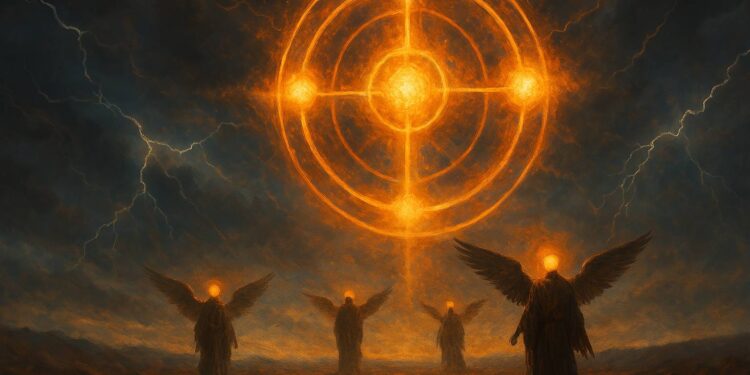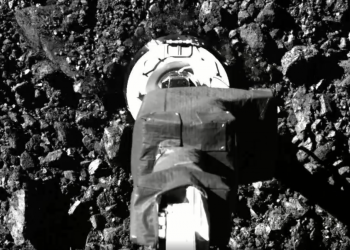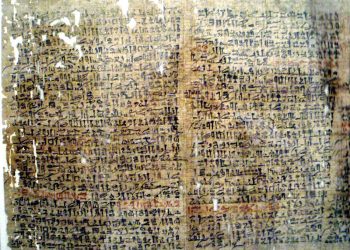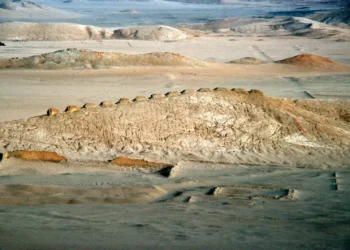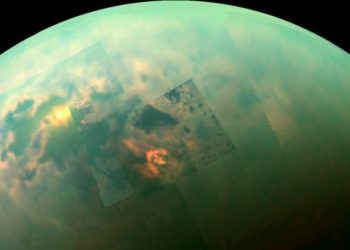In a desert exile nearly 2,600 years ago, a man looked up and saw something descend from the sky—something so radiant, so strange, and so loud that it shook him to his core. He wrote about it with the only language he had: visions, wheels, fire, and glowing metal. But was this divine prophecy—or the first time a human tried to describe a UFO?
Is the Wheel of Ezekiel the First Description of an UFO? Some believe the answer may rewrite how we interpret not just the Bible, but the possibility of contact in the ancient world.
The ancient account that still fuels modern debate
The Book of Ezekiel begins with a spectacle few ancient texts attempt to describe so vividly. “I looked,” the prophet writes, “and I saw a windstorm coming out of the north—an immense cloud with flashing lightning and surrounded by brilliant light.” From the heart of the storm, a fiery object appeared, glowing like molten metal, flanked by four living beings. Beside each, a wheel—shimmering, complex, and alive with motion.
For centuries, this scene was read symbolically. But starting in the 20th century, a provocative question emerged: Is the Wheel of Ezekiel the First Description of an UFO? And if it is, what does that mean for how we understand both scripture and history?
Swiss author Erich von Däniken was one of the first to raise this possibility in his 1968 book Chariots of the Gods?. He argued that Ezekiel was not having a religious vision, but witnessing technology—possibly an extraterrestrial spacecraft.
Von Däniken’s theory caught the attention of NASA engineer Josef F. Blumrich, who set out to debunk it. But as Blumrich analyzed the biblical text from an engineering perspective, something unexpected happened: he began to agree. By the end of his research, Blumrich published The Spaceships of Ezekiel, proposing that the prophet had encountered a structured, mechanical vehicle capable of flight. He even patented a wheel design inspired by the “wheels within wheels” Ezekiel described.
This shift—from theological vision to technological encounter—is why the question Is the Wheel of Ezekiel the First Description of an UFO continues to intrigue both scholars and skeptics alike.
Wheels that sparkled like topaz and moved in every direction
The technical detail in Ezekiel’s account is often overlooked. He doesn’t just say “a chariot” appeared. He describes it functionally. The wheels, he says, “sparkled like topaz,” and “each appeared to be made like a wheel intersecting a wheel.” These wheels could move in any direction without turning. “Their rims were high and awesome,” he adds, “and full of eyes all around”—a line some interpret as describing lights, sensors, or observation ports.
Above the beings was something like a “vault, sparkling like crystal,” a dome or canopy that hovered above the entire craft. The beings themselves had “the likeness of a man,” but with four faces, four wings, straight legs, and feet like polished bronze. They moved as one, guided not by turning but by intent—like synchronized machines.
Every element of Ezekiel’s vision, when viewed outside its religious context, evokes machinery. Fire, lightning, glowing metal, windstorms—all elements we might associate with a rocket launch or energy discharge.
That’s why many continue to ask: Is the Wheel of Ezekiel the First Description of an UFO? Because if we take his descriptions literally, they align more with aerospace engineering than divine metaphor.
Why Ezekiel’s account refuses to fade into myth
Unlike other prophetic texts in the Bible, Ezekiel speaks in the first person. He doesn’t relay a tale passed down orally or written long after the fact. He tells his story as a witness. “I looked and I saw,” he says repeatedly. There’s immediacy to his words—a rawness that suggests something real happened.
For ancient peoples, the boundary between gods and technology didn’t exist. What we now call advanced machinery would have appeared supernatural to them. Ezekiel didn’t have words for spacecraft or robotics. So he used what he knew: fire, bronze, vaults, wheels, creatures.
This opens up the deeper question at the heart of the debate: Is the Wheel of Ezekiel the First Description of an UFO, or have we misread one of the most direct eyewitness accounts in religious history?
Even today, descriptions of unidentified aerial phenomena (UAPs) often feature blinding lights, strange sounds, sudden movement, and unintelligible design. Ezekiel’s vision fits these patterns remarkably well, centuries before aviation, science fiction, or modern spacecraft existed.
And the detail about the beings having human form but not being human—“the likeness of a man”—is especially haunting. It’s not a poetic flourish; it’s a line drawn between similarity and otherness. Could Ezekiel have been trying, with every tool at his disposal, to describe not a god, but a visitor?



